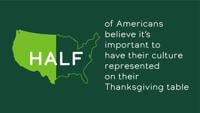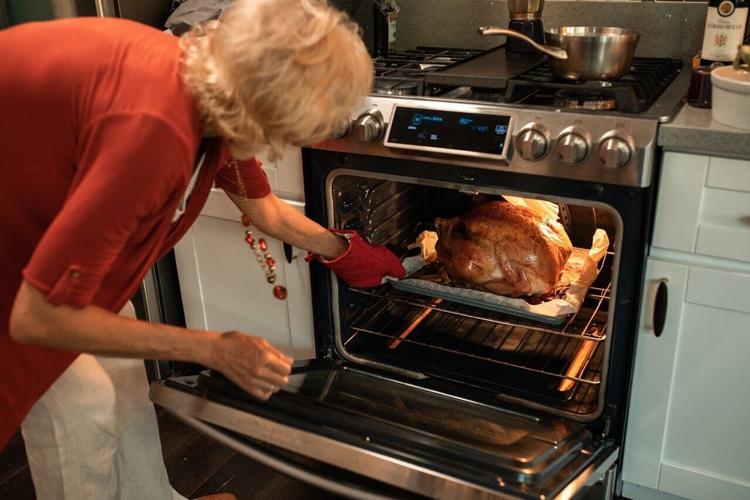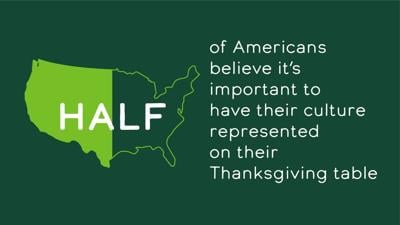
(Photo by cottonbro studio via Pexels)
According to new research, over half of Americans have a Thanksgiving recipe that’s been passed down from generation to generation within their family.
The survey of 5,000 Americans, evenly split across all 50 states, found that 55% have a treasured family recipe that’s been shared through the years.
Almost three in five (58%) African American households and 56% of Hispanic households keep these recipes alive during Thanksgiving.
More than half (52%) of those polled even revealed that recipe is over 25 years old.
Commissioned by Jennie-O and conducted by Talker Research, the survey explored some of these recipes and diverse cultural backgrounds to understand what makes Thanksgiving tables across the country unique.
Some are still a family secret, as one respondent only knew the main ingredient — potatoes — which are “stuffed with ingredients only the elders of the family have access [to]; someday I’ll have that privilege.”
Another respondent will be making a fried broccoli dish from their Italian great-grandmother, while another will be preparing Hawaiian smoked turkey with an imu.
For respondents who will be making a family recipe this holiday season, over half said they appreciate the nostalgia these dishes bring (58%), while others highlighted the joy that comes with sharing the recipe with other people (53%).

(Photo by RDNE Stock project via Pexels)
Tying into that, over a third (37%) are excited to teach the recipe to their children or grandchildren, with those in Wyoming (54%) and Michigan (53%) being the most excited.
Other respondents highlighted the cultural importance of these dishes: 29% said one of their favorite aspects of their family recipes was the reflection of their heritage and culture, while 24% said these recipes make them feel proud of their background and heritage.
The survey revealed that 50% of respondents find it important to have their culture and heritage represented on their Thanksgiving table. Respondents who identified as Black or African American, as well as Hispanic or Latino, were more likely to say this was important to them — 73% and 71%, respectively.
More than half (55%) would even take things a step further and try to recreate a recipe that originates from a different cultural background than their own, with Hispanic (73%) and African American (73%) respondents being most likely to do so.

(Talker Research)
“What stands out in this research is how deeply food connects us to our heritage,” said Kim Anderson, senior brand manager at Jennie-O. “We’re reminded that these aren’t just recipes, they’re living traditions that honor where we come from and help us share our stories with the next generation.”
When asked about hosting, 24% of respondents said they have a signature dish they’re known for — with those in Idaho (37%) and Washington (34%) most likely to agree with this.
Those with a European background strive to be the best hosts overall (26%) and both Asian and African American households are most likely to have a variety of cultural dishes on the table (both 20%).
Heritage shines through at the table when attending too: 24% of Massachusetts residents and 23% of Asian respondents say they bring culturally inspired dishes — more than any other group.
More generally, a little more than half of all Americans polled (53%) try to make themselves as helpful as possible with whatever the host needs.

Claudio Schwarz
With so many lofty goals, the average feast has five different main dishes, including the usual staples: turkey (93%) and ham (55%). Those in Connecticut are most likely to feature a baked pasta dish (36%), while one in 10 of those in New Mexico (11%) have carne asada on their table.
According to the results, most of those who will have turkey on their table this year will bake it (76%), though those in Alabama are most likely to smoke their turkey (24%), 14% of those in Hispanic households prefer to grill it and 18% of those in African American households opt to fry it.
On top of that, the average feast this year will also feature an additional seven side dishes, though 23% will feature more than 10 options on the table
The survey revealed America’s “turkey time,” or the best time to sit down and feast. According to the results, the average mealtime is 2:54 p.m.
Those in Washington average the latest at 4:12 p.m. — and those in Iowa, Louisiana, Maine and Mississippi sit down the earliest at 1:54 p.m.
“This research confirms what makes Thanksgiving so special: no two celebrations look alike,” said Anderson. “The holiday is about honoring what is important for your family and culture, because at the end of the day, togetherness is what we’re really celebrating.”

(Photo by cottonbro studio via Pexels)
AMERICA’S MOST UNIQUE, TREASURED FAMILY RECIPES
“All I know is the main ingredient [is] potatoes that are stuffed with ingredients only the elders of the family have access [to], someday I'll have that privilege.”
“Green [gelatin] marshmallow cranberry surprise - the rest is classified” (European background)
“Caldo de res verde, it has a lot of vegetables like green beans, corn, carrots, and meats, plus the soup is made with a hint of spiciness from using jalapenos” (Hispanic/Latino background)
“Cheeseburger casserole and even though it doesn't seem for Thanksgiving I have to make it, everyone expects it”
“Chicken or seafood gumbo, a Cajun/Creole stew made with a rue, garlic, onions, sausage [and a] bay leaf” (European background)
“Fried broccoli started with my great grandmother from Italy. Broccoli is boiled and then put in [a] cast iron skillet in olive oil with garlic. Someone stands at the stove and smashes it with a fork until it is smooth and all the chunks are gone.” (European background)
“Hawaiian smoked turkey. Cooked imu (hot rocks underground style) turkey, soy and ginger marinated with roasted Hawaiian sweet potatoes in the imu as well”

(Photo by Anna Shvets via Pexels)
Survey methodology:
Talker Research surveyed 5,000 state-by-state U.S. adults (100 in each state) with targeted quotas to achieve statistical significance for European, Hispanic, Asian, and African American households; the survey was commissioned by Jennie-O and administered and conducted online by Talker Research between Oct. 1 and Oct. 10, 2025.
We are sourcing from a non-probability frame and the two main sources we use are:
- Traditional online access panels — where respondents opt-in to take part in online market research for an incentive
- Programmatic — where respondents are online and are given the option to take part in a survey to receive a virtual incentive usually related to the online activity they are engaging in
Those who did not fit the specified sample were terminated from the survey. As the survey is fielded, dynamic online sampling is used, adjusting targeting to achieve the quotas specified as part of the sampling plan.
Regardless of which sources a respondent came from, they were directed to an Online Survey, where the survey was conducted in English; a link to the questionnaire can be shared upon request. Respondents were awarded points for completing the survey. These points have a small cash-equivalent monetary value.
Cells are only reported on for analysis if they have a minimum of 80 respondents, and statistical significance is calculated at the 95% level. Data is not weighted, but quotas and other parameters are put in place to reach the desired sample.
Interviews are excluded from the final analysis if they failed quality-checking measures. This includes:
- Speeders: Respondents who complete the survey in a time that is quicker than one-third of the median length of interview are disqualified as speeders
- Open ends: All verbatim responses (full open-ended questions as well as other please specify options) are checked for inappropriate or irrelevant text
- Bots: Captcha is enabled on surveys, which allows the research team to identify and disqualify bots
- Duplicates: Survey software has “deduping” based on digital fingerprinting, which ensures nobody is allowed to take the survey more than once
It is worth noting that this survey was only available to individuals with internet access, and the results may not be generalizable to those without internet access.




























(0) comments
Welcome to the discussion.
Log In
Keep it Clean. Please avoid obscene, vulgar, lewd, racist or sexually-oriented language.
PLEASE TURN OFF YOUR CAPS LOCK.
Don't Threaten. Threats of harming another person will not be tolerated.
Be Truthful. Don't knowingly lie about anyone or anything.
Be Nice. No racism, sexism or any sort of -ism that is degrading to another person.
Be Proactive. Use the 'Report' link on each comment to let us know of abusive posts.
Share with Us. We'd love to hear eyewitness accounts, the history behind an article.